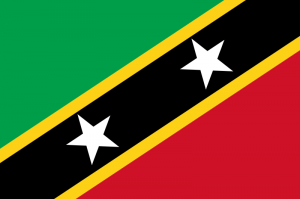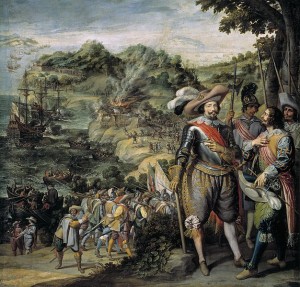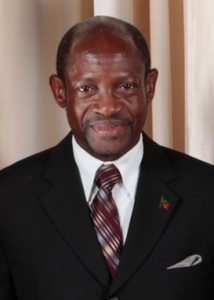Saint Kitts and Nevis

History Book Review: St. Kitts and Nevis: Portrait of a Nation Celebrating 25 Years of Independen
This is the summary of St. Kitts and Nevis: Portrait of a Nation Celebrating 25 Years of Independence by Tomothy Harris.
The Federation of Saint Christopher and Nevis (![]() i/seɪnt ˌkɪts ænd ˈniːvɪs/; also known as the Federation of Saint Kitts and Nevis), located in the Leeward Islands, is a federal two-island country in the West Indies. It is the smallest sovereign state in the Americas, in both area and population.
i/seɪnt ˌkɪts ænd ˈniːvɪs/; also known as the Federation of Saint Kitts and Nevis), located in the Leeward Islands, is a federal two-island country in the West Indies. It is the smallest sovereign state in the Americas, in both area and population.
The capital city and headquarters of government for the federated state is Basseterreon the larger island of Saint Christopher. The smaller island of Nevis lies about 2 miles (3 km) southeast of Saint Kitts, across a shallow channel called “The Narrows”.
Historically, the British dependency of Anguilla was also a part of this union, which was then known collectively as Saint Christopher-Nevis-Anguilla. Saint Kitts and Nevis are geographically part of the Leeward Islands. To the north-northwest lie the islands of Sint Eustatius, Saba (the Netherlands), Saint Barthélemy, Saint-Martin/Sint Maarten and Anguilla. To the east and northeast are Antigua and Barbuda, and to the southeast is the small uninhabited island of Redonda, and the island of Montserrat, which currently has an active volcano (see Soufrière Hills).
Saint Kitts and Nevis were among the first islands in the Caribbean to be settled by Europeans. Saint Kitts was home to the first English and French colonies in the Caribbean, and thus has also been titled “The Mother Colony of the West Indies.”
Etymology
Saint Kitts was named “Liamuiga” by the Kalinago Indians who inhabited the island. This name, roughly translated, in English means “fertile land,” a testimony to the island’s rich volcanic soil and high productivity.
Nevis’s pre-Columbian name was “Oualie,” which translates to “land of beautiful waters,” presumably referring to the island’s many freshwater springs and hot volcanic springs.
Christopher Columbus, upon sighting what we now call Nevis in 1493, gave that island the name San Martin (Saint Martin). However, the confusion of numerous, poorly charted small islands in the Leeward Island chain, meant that the name ended up being accidentally transferred to another island, the one which we now know as the French/Dutch island Saint-Martin/Sint Maarten.
The current name “Nevis” is derived from a Spanish name Nuestra Señora de las Nieves (The original name was the archaic Spanish “Noestra Siñora delas Neves”), by a process of abbreviation and anglicisation. This Spanish name means Our Lady of the Snows. It is not known who chose this name for the island, but it is a reference to the story of a fourth-century Catholic miracle: a snowfall on the Esquiline Hill in Rome. Presumably the white clouds which usually wreathe the top of Nevis Peak reminded someone of the story of a miraculous snowfall in a hot climate. The island of Nevis, upon first British settlement, was referred to as “Dulcina,” a name meaning “sweet one.” Its original Spanish name, “Nuestra Señora de las Nieves,” was eventually kept however, though it was soon shortened to “Nevis.”
There is some disagreement over the name which Columbus gave to St. Kitts. For many years it was thought that he named the island San Cristobal, after his patron saint Saint Christopher, the saint of travelling. However, new studies suggest that Columbus named the island Sant Yago (Saint James). The name “San Cristobal” was apparently given by Columbus to the island now known as Saba, 20 miles northwest. It seems that “San Cristobal” came to be applied to the island of St. Kitts only as the result of a mapping error.
No matter the origin of the name, the island was well documented as “San Cristobal” by the 17th century. The first English colonists kept the English translation of this name, and dubbed it “St. Christopher’s Island.” In the 17th century Kit, or Kitt, was a common nickname for the name Christopher, and so the island was often informally referred to as “Saint Kitt’s island,” which was further shortened to “Saint Kitts.”
Today, the Constitution refers to the state as both “Saint Kitts and Nevis” and “Saint Christopher and Nevis,” but the former is the one most commonly used.
History of Saint Kitts and Nevis
 The Spanish capture of Saint Kitts by Don Fadrique de Toledo in 1629.
The Spanish capture of Saint Kitts by Don Fadrique de Toledo in 1629.
Five thousand years prior to European arrival, the island was settled by Native Americans. The last wave of Native American arrivals, the Kalinago people, arrived approximately three centuries before the Europeans. The islands were discovered by the Europeans through a Spanish expedition under Columbus in 1493. In 1538, French Huguenots established a settlement on St. Kitts but the settlement was destroyed by the Spanish soon afterwards and the survivors were deported. In 1623, an English settlement was established, which was soon followed by French settlements, the island being divided by agreement. Dissimilar to many other islands, the local Kalinago people on the island allowed Europeans to colonise Saint Kitts. In 1626, the Anglo-French settlers massacred the Kalinago, pre-empting a plan by the Kalinago to drive the foreigners from the island.
A Spanish expedition, sent to enforce Spanish claims, destroyed the English and French colonies and deported the settlers back to their respective countries in 1629. As part of the war settlement in 1630, the Spanish permitted the re-establishment of the English and French colonies.
As Spanish power went into decline, Saint Kitts became the premier base for English and French expansion into the Caribbean, as the islands of Antigua, Montserrat, Anguilla and Tortola for the English, and Martinique, the Guadeloupe archipelago and St. Barts for the French were colonised from it. During the late 17th century, France and England battled for control over St Kitts. It was ceded to Britain in 1713.
Although small in size, and separated by only 2 miles (3 km) of water, the two islands were viewed and governed as different states until the late 19th century, when they were forcibly unified along with the island of Anguilla by the British. To this day relations are strained, with Nevis accusing Saint Kitts of neglecting its needs.
Saint Kitts and Nevis, along with Anguilla, became an associated state with full internal autonomy in 1967. Anguillians rebelled, and separated from the others in 1971. St. Kitts and Nevis achieved independence in 1983. It is the newest sovereign state in the Americas. In August 1998, a vote in Nevis on a referendum to separate from St. Kitts fell short of the two-thirds majority needed. In late September 1998, Hurricane Georges caused approximately $458,000,000 in damages and property and limited GDP growth for the year and beyond. Georges was the worst hurricane to hit the region in the century.
In 2013, CARICOM called for European nations to pay reparations for slavery and established an official reparations commission.
Politics of Saint Kitts and Nevis
 Denzil Douglas, Prime Minister of Saint Kitts and Nevis
Denzil Douglas, Prime Minister of Saint Kitts and Nevis
Saint Kitts and Nevis is a sovereign, democratic and federal state. The Queen of Saint Christopher and Nevis, Elizabeth II, is its head of state. The Queen is represented in the country by a Governor-General, who acts on the advice of the Prime Minister and the Cabinet. The Prime Minister is the leader of the majority party of the House, and the cabinet conducts affairs of state. The country may also be described by the unofficial term, “Commonwealth realm“, because it is a constitutional monarchy which shares the same monarch as some other members of the Commonwealth of Nations.
St. Kitts and Nevis has a unicameral legislature, known as the National Assembly. It is composed of fourteen members: eleven elected Representatives (three from the island of Nevis) and three Senators who are appointed by the Governor-General. Two of the senators are appointed on the advice of the Prime Minister, and one on the advice of the leader of the opposition. Unlike in other countries, senators do not constitute a separate Senate or upper house of parliament, but sit in the National Assembly, alongside representatives. All members serve five-year terms. The Prime Minister and the Cabinet are responsible to the Parliament.
Saint Kitts and Nevis is a full and participating member of the Caribbean Community (CARICOM) and the Organisation of Eastern Caribbean States (OECS).


